Java
> Cafetux
> Dev
Persistance
Struts 2 – create friendly URL with urlrewritefilter.
Why do you need friendly URL?
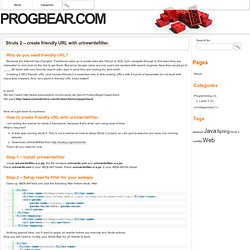
Because the Internet has changed. Traditional users go to portal sites like Yahoo! Or AOL.com, navigate through to find topic they are interested in, and click on the link to get there. But since Google came around, users are spoiled with search engines. Now they would go to ____ (fill black with your favorite search site), type in what they are looking for, and click!!
Java Learning & Certification Community, free Java JavaEE scjp spring hibernate jpa mock courses and exams.
Rich-UI
Xml. Penser en Java. Encoding. " Les bonnes pratiques avec Struts – afficher les formulaires en UTF-8" par Le weblogue de SeB. Voici un troisième billet dans la série sur Les bonnes pratiques avec Struts.

Introduction A partir du moment où une application doit être internationalisée, il est intéressant d’utiliser l’encodage UTF-8 par défaut. Dès lors, un problème d’affichage des valeurs des formulaires se pose avec certains caractères[1]. Solutions Il existe deux solutions courantes pour répondre à ce problème, qui s’implémentent : dans les méthodes reset() et validate() de la classe ActionFormavec des filtres des servlets ActionForm.reset & ActionForm.validate Il suffit simplement d’implémenter ces deux méthodes dans tous vos ActionForm : Cette méthode fonctionne bien.
Using Terracotta to increase heap space beyond limits of 32-bit jvm. 'm not sure if I made my question clear.
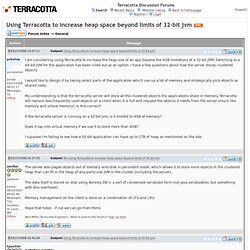
Does the server hold every single shared object in its memory? Or is the server managing the memory of all the connected JVMs, and moving objects between them to make a larger heap (up to 4GB*<# of JVMs>)? (on 32-bit JVMs.) Yes Let me explain in more detail - hope it helps. The Terracotta Server cluster always has the most up to date version of the objects in the clustered heap. It acts as a peer to all members in the cluster. The Terracotta server(s) can move data in and out of their local heap to disk, so the data they store is not limited to any one JVM physical heap size.
The cluster members, we refer to the them as Terracotta clients or "L1"s, page data in and out of their physical heap (to and from the Terracotta servers, or "L2"s) as necessary.
BigMemory for Enterprise Ehcache. Quelques notes sur Java. Design patterns pour Java: Les 23 ...
jBPM. jBPM is a flexible Business Process Management (BPM) Suite.

It makes the bridge between business analysts and developers. Traditional BPM engines have a focus that is limited to non-technical people only. jBPM has a dual focus: it offers process management features in a way that both business users and developers like it. What does jBPM do? A business process allows you to model your business goals by describing the steps that need to be executed to achieve that goal and the order, using a flow chart. This greatly improves the visibility and agility of your business logic, results in higher-level and domain-specific representations that can be understood by business users and is easier to monitor. The core of jBPM is a light-weight, extensible workflow engine written in pure Java that allows you to execute business processes using the latest BPMN 2.0 specification. jBPM is also not just an isolated process engine.
Tests
Android. Chart. JFreeChart is a free 100% Java chart library that makes it easy for developers to display professional quality charts in their applications.

JFreeChart's extensive feature set includes: For a closer look at JFreeChart, please try the extensive demo application included in the download or browse the Samples page. Latest News 31 July 2014 JFreeChart 1.0.19 is now available. 3 July 2014 JFreeChart 1.0.18 is now available and features a JavaFX ChartViewer control and numerous other enhancements. 24 November 2013 We are pleased to announce the availability of JFreeChart 1.0.17. 13 September 2013 We are pleased to announce the availability of JFreeChart 1.0.16. 4 July 2013 JFreeChart 1.0.15 has been posted to the download page at SourceForge. 11 Sep 2012 A development version of JFreeChart is now hosted on GitHub.
The Project The JFreeChart project was founded fourteen years ago, in February 2000, by David Gilbert.
JDK Development Tools. General General Information (file structure, classpath, how classes are found, changes) Standard JDK Tools and Utilities Basic Tools (javac, java, javadoc, apt, appletviewer, jar, jdb, javah, javap, extcheck) Security Tools (keytool, jarsigner, policytool, kinit, klist, ktab) Internationalization Tools (native2ascii) Remote Method Invocation (RMI) Tools (rmic, rmiregistry, rmid, serialver) Java IDL and RMI-IIOP Tools (tnameserv, idlj, orbd, servertool) Java Deployment Tools (pack200, unpack200) Java Plug-in Tools (htmlconverter) Java Web Start Tools (javaws) Experimental JDK Tools and Utilities NOTE - The tools described in this section are unsupported and experimental in nature and should be used with that in mind.
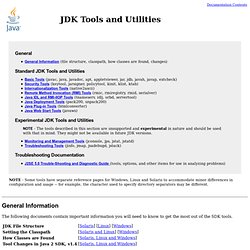
SLF4J – Problèmes et solutions. SLF4J (Simple Logging Facade For Java) est une API d’abstraction de frameworks de log de plus en plus adoptée.

Lorsque j’ai découvert cette API j’étais surtout fasciné par l’élégance des messages paramétrés utilisant des placeholders et par la simplicité de changement du framework de logging (juste en modifiant le classpath). La puissance de l’implémentation native Logback m’a fait adopter le couple SLF4J/Logback.
Home - Gradle. Java - Les types de données. Mars 2014 Les types primitifs Java est un langage orienté objet, c'est-à-dire qu'il manipule des classes, ou plus exactement des objets, qui sont des instances de ces classes.
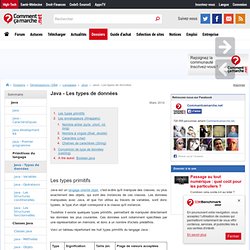
Les données manipulées avec Java, et que l'on utilise au travers de variables, sont donc typées, le type d'un objet correspond à la classe qu'il instancie. Toutefois il existe quelques types primitifs, permettant de manipuler directement les données les plus courantes. Ces données sont notamment spécifiées par une représentation en mémoire, et donc à un nombre d'octets prédéfinis.
Final : un bytecode peut en cacher un autre. Quand le résultat d’un code Java me surprend, je regarde son bytecode avec javap -c.

Prenons un exemple. Dans notre équipe, nous mettons les variables à final par défaut pour éviter des problèmes de concurrence [1]. J’ai découvert[2] que final pouvait changer le comportement de l’opérateur ternaire ? :, comme le montre ce code : qui affiche :
Convert a Java OutputStream to an InputStream. If you have ever programmed using Java IO, you will quickly run into a situation in which a class creates data on an OutputStream and you need to send it to another class that expects to read the data from an input stream.
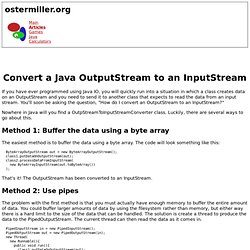
You'll soon be asking the question, "How do I convert an OutputStream to an InputStream?
" Nowhere in Java will you find a OutpStreamToInputStreamConverter class. Luckily, there are several ways to go about this.










